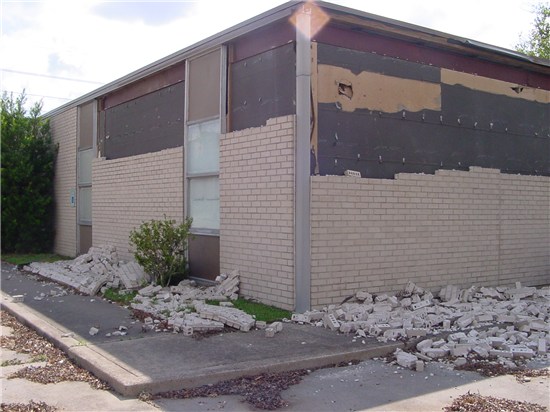By Peter J. Cass, OD

Damage to Dr. Cass’s office from one of the two hurricanes to hit his practice within three years. Dr. Cass recommends contacting the insurance company as soon as possible, and re-opening to see patients–even if the office repairs are not yet complete.
January 21, 2015
Within three years, my Beaumont, Texas, practice was impacted by two hurricanes–Hurricane Rita in 2005 and Hurricane Ike in 2008. Both of these storms damaged our office and interrupted our operations. An essential component of our recovery was the money received by filing loss-of-business claims with our office and practice insurance providers.
We received approximately $40,200 for both losses we filed after these storms, and it took about three months from the date of loss to receive the money.
Fortunately, our insurance was sufficient to cover most of our losses, and while I would not change coverage, I understand the process much better now. I was surprised that the total loss of income was not covered (gross income). Loss of business insurance only covers the net amount of income that was lost. Here is what I learned.
What Is Loss-of-Business Coverage?
Loss of business coverage is usually included as part of a standard commercial property insurance policy. It is often added to the policy as an “endorsement” to the policy (also called a “rider” or “addendum”). Practice owners should take a look at their policy to confirm that loss of business insurance is included, if it is something they want for their practice.
Burglary, fire, or vandalism, could also lead to a loss of business claim. Anything that is covered in the insurance policy should also cover loss of business when appropriate.
Is There a Max or Cap to Coverage?
Insurance policies that include loss of business usually limit it to the Actual Loss Sustained (ALS). Practice owners will have to prove the amount of business that was lost as a result of the event that caused damage to the business and prevented it from operation. The maximum amount payable would typically be limited by the amount of the policy.
There are no restrictions on how the money gained from a loss-of-business claim can be spent, as technically the money spent would be net profit in the business, and thus, available to the owner to use as desired.

The inside of Dr. Cass’s office during the repair process following one of the two hurricanes to hit his office between 2005 and 2008. Dr. Cass says that as soon as his phone service was restored, patients were calling for appointments.
When Do You File Loss-of-Business Claim?
Loss of business claims may have a waiting period as short as 24 hours, and 72 hours is common. This waiting period is often the deductible of the loss of business insurance policy, so if your business is only closed for a short period of time after a disaster, it may not be worth the trouble. For most small practices the inability to open the office for one week or more would probably be worth making a claim. Practice owners will need to look at their insurance policy for a waiting period (sometimes called an “elimination period”).
What is First Step to Filing a Claim?
If a practice owner feels that they have a significant claim, the first step is to review the commercial business insurance policy and then contact the insurance company to let them know about the claim. The insurance company will let you know what information they expect you to provide to them.
What Do You Need to Give Insurance Company?
Complete and accurate documentation, as well as quickly responding to requests for information from the insurance company, helps to ensure the fastest payment.
Practice owners should provide:
• Dates that the business was unable to operate due to the claim damage
• Tax returns (to show historical income)
• Monthly profit and loss statements (to show breakdown of historical income)
• Payroll reports (historical and during the period of loss)
• Budgets for the period of loss
• Projections for the period of loss
I tried to provide as many documents as possible electronically, so that I would have a record of what I provided, and so that I could get them to the insurance company as quickly as possible. I saved reports from our office management software and our bookkeeping software in PDF format, scanned our tax returns, and e-mailed excel spreadsheets.
What if you feel you haven’t been offered enough for the loss?
If the practice owner disagrees with the insurance adjustor the first step is to try to talk to the adjustor and explain your reasoning and calculations. The practice owner may be asked to provide additional documentation or calculations. If that does not work, you can try contacting the customer services department of the insurance company and asking them to review the case.

Peter J. Cass, OD, is a partner in Practice Compliance Solutions, a faculty member for the University of Houston College of Optometry, an associate at MyEyeDr. Beaumont and past-president of the Texas Optometric Association. To contact: peter@PCScomply.com

























